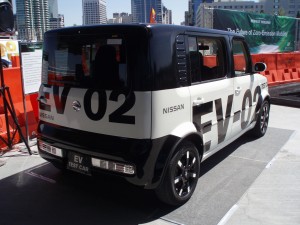
By Tom Bartley (3/26/09).
Walking up to the new Nissan Electric Vehicle prototype car, my first surprise was getting into the right hand front seat. This car was only one of two in existence and driving in Japan is like the UK, on the left side of the road. I had never driven a right hand drive car before, but I felt more comfortable to see the brake pedal on the left and the accelerator pedal on the right. The only real difference was using my left hand to release the parking brake and move the shift lever to DRIVE.
I was excited to receive the invitation to test drive the new Nissan EV during its announcement with San Diego Gas and Electric in San Diego on Monday, March 23, 2009. This was to be a limited rollout using a “mule” and not the actual car, but I knew all that and still wanted to feel what it was like to drive it. I didn’t pay much attention to the style looks or interior of the car because Nissan is developing the final production model with a different body in Japan.
This electric vehicle was so quiet, I worried just a little about the absent minded driver who would accidentally step on the accelerator without realizing this quiet car was ready to go.
As I eased my foot into the accelerator I asked the company driver if I could floor it. He agreed and I looked for an opportunity. Not much distance at first because we started out on the short side of the course along the pier. The course was conveniently laid out such that the high speed long side would put me into the water if something failed and I couldn’t stop. Definitely not a golf cart, the accelerator had some real control. The car felt so comfortable that by the time I turned around and headed down the long side I had forgotten about driving from the right side.
The longer part of the course allowed a quick acceleration to 70 km/h (45 mph) on the speedometer before I tested the braking regeneration, not wanting to test the Port’s capability to recover me out of the water. Nissan’s more than 18 years of electric vehicle experience was evident by the control smoothness and no transmission design. Driving the car felt like an ordinary gasoline car with the extra spirit of a turbo kick after an initial start up.
I have driven many of the electrically propelled vehicles, including the fuel cell million-dollar prototypes, and I am familiar with the high torque off-the-line acceleration of electric motors. Nissan was successful in making this car feel like any other gasoline car I was used to driving on the road. I can’t say enough about the control system because I have observed how difficult that can be in an electric vehicle. It’s not a sports car, but neither will parents with kids have any trouble keeping up with traffic or staying out of the way.
The test mule prototype was a square bodied five passenger, four door, mini SUV that looked like an oversized bread box or a shrunken HUMMER. I saw the car take one trip around the pier track where I estimated the people load to be in excess of 700 pounds. The acceleration performance seemed to be the same as when only two of us were in the car. If the car handles the same empty or loaded, that’s HUGE.
Charging options are a standard 4 hour, special 26 minutes, or emergency to get me home. Nissan and SDG&E are working towards making available pre approved according-to-code installations through the county.
One thing for sure, the car recycles braking energy and the number of brake jobs will be few and far between.
How much is it going to cost? Nissan is acting coy, but probably around $30,000 plus or minus. Don’t go away yet; it qualifies for the $7500 EV tax credit, making it somewhat competitive with small hybrid electrics. Nissan says that the car will save money unless gasoline drops below $1.10 per gallon (fat chance of that ever happening again). I don’t believe the quoted 90 cents to “fill the tank”, but maybe SDG&E has something up its sleeve with special charging rates in the middle of the night using the smart meters now being installed around the San Diego area.
Ok, I’d like to have one. When can I get one? Nissan is planning to provide 100 fleet vehicles in San Diego through SDG&E. I saw conflicting reports on whether SDG&E was planning to use all 100 vehicles or would offer some of those vehicles to other fleets. Nissan would like that number to go to 1,000 in preparation for a full blown production and will be accepting “soft” fleet orders during the next 12 months for probable delivery in 2011. The general public won’t have its turn until 2012. If I can sell my gas guzzling high performance high maintenance Corvette Classic I might look for a way to get one of the fleet cars.
